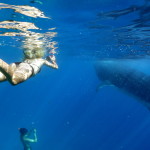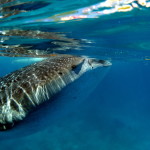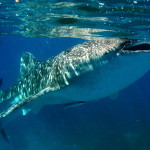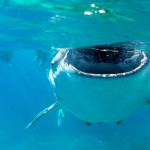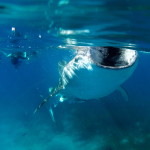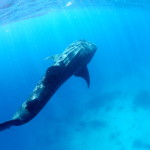A decade or so ago, whale sharks gathered by the hundreds in the area around Oslob, Philippines, feeding on tiny shrimp that came to the surface and close to shore in the moonlight. Fishermen also caught these same shrimp and thus competed with the sharks for their catch. Hearing about these sharks, some fishermen from Bohol came into the area and slaughtered whale sharks by the hundreds for their meat and fins. Only in the last couple of years have the sharks begun to return, albeit in smaller numbers.
Eventually, the local fishermen realized they could feed the sharks the shrimp from their catch and the sharks would hang out in the area, which brought tourists to the area to see the sharks during feeding. And so the now well-known whale-shark encounter in Oslob began.
Area residents have greatly benefited from the income and the sharks are fed something from their normal diet, but the shark feeding in Oslob has garnered a fair amount of controversy. We had read some pretty horrendous things about the practice there, so we decided to go and see for ourselves. What we found was that the reports we’d read were much exaggerated and in some cases, outright lies. Despite the fact that things aren’t as bad as has been reported, I still have mixed feelings about the activities. Read on to decide for yourself.
When we first got there I was struck by the number of rules involved, all of them useful. Before even purchasing our tickets, we were given an orientation.
- No touching the sharks. If the shark appears to be on a collision course with you, move out of the way.
- No feeding the sharks. The fishermen will do that and they feed them small shrimp that are part of their normal diet.
- No chasing the sharks. If the shark decides to leave, then it shouldn’t be chased down. It should be allowed to leave unhindered.
- Keep 4 meters (12 feet) between you and the shark.
- No sunscreen. The sharks filter feed and thus suck in massive quantities of water. That water shouldn’t be full of sunscreen.
- No propeller boats allowed in the area. They could damage the sharks.
After we bought our tickets, we were paddled out to the shark area and allowed to get into the water with or without fins, mask and snorkel. We were given an hour with the sharks, but only because we paid extra — regular tickets only give you 30 minutes of swim time.
It was moderately busy while we were there, and even though it wasn’t packed, it was somewhat crowded. However, I didn’t notice that so much once we were in the water with the sharks. We were free to swim wherever we wanted, provided that we obeyed the aforementioned rules. And that’s exactly what we did — swim from shark to shark, watch all that was going on, and try to get some decent pics. The sharks primarily stayed at the surface, close to the boats that were feeding them. They seemed fairly oblivious to our presence and only reacted if they were accidentally touched.
So — is the Oslob shark-feed a good thing, or a bad thing? Personally, I think it’s a mixture of both. I can see a few potential problems resulting from these sharks seeing boats and people as a source of food. While the boats operating around this activity are paddleboats only, the sharks could possibly approach propeller boats expecting to be fed by them too. This is speculation since that hasn’t been known to happen, but it is still a possible concern.
On the positive side, what we observed was a far cry from the horrors we’d seen spelled out in other articles over the last couple of years. All-in-all, it was a peaceful experience that allowed a number of people the opportunity to see these gentle giants firsthand, and to gain a new respect for them. While I would prefer to see the sharks without baiting, many people don’t have the opportunity to do so, and this experience offers them an inexpensive way to see these majestic sharks up close. And as long as the sharks are a source of income for locals, they’re worth far more alive than dead, and not seen as competition for a limited food source. My hope is that perhaps a few participants in this activity come away with a new respect for protecting ocean critters, sharks in particular. As for the controversy, you must decide for yourself — after all, that’s why we went.
The post Snorkeling with Whale Sharks in Oslob appeared first on Scuba Diver Life.
